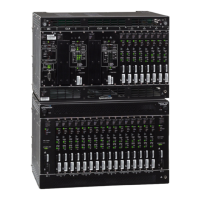1
097-55501-01 Issue 6 – June 2003 37
2
5
3
Description
master shelf will accept PRS (5 or 10 MHz) and DS1 inputs as timing
references whereas a remote shelf accepts Composite Clock (CC) inputs as
the timing reference(s). Typically, a remote shelf takes its CC timing inputs
from a TimeHub or DCD master shelf, both which are capable of providing
CC outputs.
Another major difference between the two shelf configurations is that the
remote shelf does not provide performance monitoring data, which is
available for the PRS and all DS1 inputs on a master shelf. For more
information on performance monitoring, see that section in the TimeHub
5500 TL1 Reference Manual (097-55501-02).
The passthrough capability is currently not available in the remote shelf.
1.5 Remote Shelf Capability
The TimeHub Remote Shelf provides the capability to effectively extend the
timing capability of a master shelf to a location physically remote from the
master (up to 3000 feet). The timing links between master and remote are
CC signals output from the master and accepted as input timing references
at the remote shelf. The remote shelf clocks follow the input CC signals
closely, which allows phase alignment of CC in to CC out to be maintained
on the remote shelf. Unlike a master shelf, which provides significant
filtering of the input timing references (PRS or DS1 signals), the remote shelf
adjusts the outputs very quickly as changes occur on the CC inputs. Since
the input CCs are being distributed from a master shelf that has already
performed the desired filtering on its inputs, only small timing variations
would typically be expected at the remote shelf inputs.
The most significant difference between master and remote shelf operation is
in the type of timing reference used for input. The remote shelf provides the
same output distribution capability that is provided by a master shelf.
In addition to accepting up to two CC signals as timing references, the
remote shelf can accept up to two DS1 inputs which are used to extract SSM
information only.
A typical setup for a master/remote shelf combination would include:
• Two CC outputs taken from master shelf connected as CC inputs
on remote shelf. The reason to use two outputs is for redundancy.
Toward this end, to isolate the signal paths as much as possible,
each CC could be taken from a different output group on the
N
OTE
: The DS1 lines will not be used to extract synchronization
signals, just the SSM messages.

